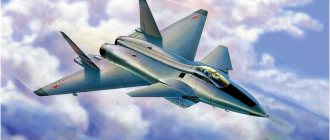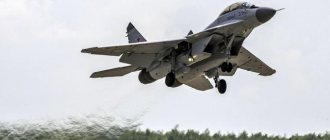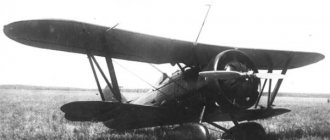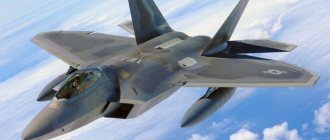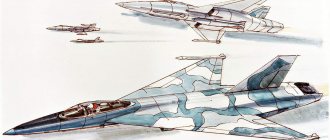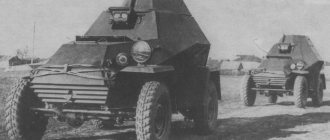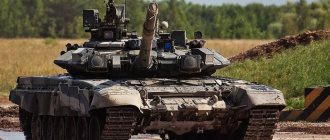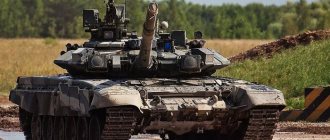Russian designers designed a fighter, which was designated as the MiG-1.44. It was a multifunctional front-line vehicle of a new generation.
It was manufactured as a response to the F-22 aircraft, which was created by American designers, but the domestic machine had better characteristics. The most important difference and advantage of the domestic fighter was that it was planned to install new engines that changed the thrust vector. This device was equipped with new stealth technologies. A special feature of the vehicle was that all the weapons were placed in the middle of the hull. To hide the aircraft in flight, the designers equipped the body with a radio-absorbing coating, which had an uneven surface, which made the aircraft less noticeable to enemy radars.
History of the creation of the MiG-1.44 fighter
The design of this fighter began in 1979 as part of the “90s fighter” project. At the beginning of 1981, requirements and recommendations for the creation of a new fighter were developed. The new car was to have a canard-type design, and the wings were to be triangular in shape with a large number of surfaces that were located at different angles. At the same time, the wing structure must have excellent aerodynamic qualities at various flight speeds and when performing maneuvers.
The development of the project began actively in 1983 at the Mikoyan design bureau. At the beginning of the design, the comprehensive development of all parts of the device was approved. In the middle of 1987, the MiG-1.44 aircraft project was defended, and four years later the prototype of the aircraft was defended. After all the approvals from the management, the MiG-1.44 aircraft received the designation “MFI”, which meant that the new machine is a multifunctional fighter that must carry out combat missions at the front.
According to the government's order and the designers' plans, the aircraft had to meet the following indicators:
- the machine must fly at supersonic speeds with the afterburner turned off;
- super maneuverability;
- very low thermal signature and radar visibility;
- excellent performance during landing and takeoff;
- the most important indicator was the reduction in fuel consumption during the flight, which in turn would reduce the cost of the flight. It is worth noting the fact that the designers thought about saving money at every stage of the design;
- the aircraft must be distinguished by a high degree of integration of all aircraft systems.
This project did not find further development and did not go into mass production, because preference was given to fighters from other design bureaus. The MiG-1.44 aircraft project was closed in 1999. At that time, only one device was ready and four more were in the process of production. Today there is only one flying prototype, which no one really needs. In 2013, this car was located in the open air on the territory of the Gromov Flight Research Institute. At the moment, the aircraft is mothballed and placed in a hangar.
Together with the production of the MiG-1.44 fighter, the design of a reconnaissance aircraft and a naval fighter based on this aircraft was underway. Based on the MiG-1.44, an aircraft was manufactured for static tests, which was designated 1.42. A highly modified aircraft was also manufactured, designated model 1.46. It was significantly superior to a standard aircraft.
MiG-41: Fighter of hypersonic missiles and satellites
Russian aircraft developers have resumed talk about the imminent appearance of a new fighter capable of fighting hypersonic missiles and space satellites
The concept of “hypersound,” seemingly purely physical, has recently acquired additional meaning. In the slang of military and military designers, for the sake of simplicity, they began to designate existing, developing and promising types of weapons capable of reaching speeds above 5 speeds of sound. This is a lower speed limit chosen by experts to formally distinguish aircraft that can exceed this barrier from those that move more slowly.
MiG-41 - why is it?
Quite regularly, hints are launched into the press that the developers will soon be ready to present the newest MiG-41 fighter. Despite the fact that, it seems, the question of what exactly and how exactly they are going to present this car is being deliberately obscured - in the form of a set of enthusiastic definitions, in the form of a concept, in the form of a model at an exhibition or even for testing (such speeches were also heard) - no more or less realistic characteristics of the aircraft are given.
Only one thing was said with certainty: the device would be ready to shoot down “strategic bombers, ballistic missiles and satellites.” Sometimes it was added that hypersonic missiles too. And that the speed of the fighter will be at least 4 sonic speeds - or Mach 4, as experts say.
So outside observers, not privy to the secrets, could only shrug their shoulders: in fact, nothing real is known, but from experience we can conclude that the dumping of such information was done for a reason. It looks like a clear echo of the aggravation in the competition between designers, caused, as often happens, by some statement from the military. Which, in turn, is born of a difficult problem of choice due to the inevitable lack of funds to develop everything that the military would like...
However, statements by authoritative people have been recorded - at the level, for example, of Sergei Korotkov, vice president for innovation of the United Aircraft Corporation. He is also the Chairman of the Board of Directors of JSC Russian Aircraft Corporation MiG. So, he indicated that the MiG-41 will be a new generation machine, designed to replace the heavy MiG-31 interceptor fighter.
MiG-31. Photo: www.globallookpress.com
What is our MiG-31? This is a long-range supersonic all-weather fighter, which, in the MiG-31K modification, is today part of the Kinzhal complex, carrying the hypersonic missile of this complex. Let's make a note of this.
The second is the characteristics of the aircraft themselves. The maximum height reached on it is 37,650 meters. The car reaches the 25 km echelon with ease. Subsonic practical range with 4 missiles – up to 2400 km. The record for non-stop flight is about 8,000 km with two refuelings. Speed - up to 3000 km/h. Thus, the aircraft can strike the enemy without entering his air defense zone.
Third, the existing capabilities of the machine. Generally, it was intended to repel group attacks of cruise missiles. Four MiG-31s completely cover a front of a thousand km. But very interesting modifications were developed (which means the documentation remained, even if the project was not implemented). For example, the MiG-31D was intended to work as part of the 30P6 “Contact” anti-satellite system, where it was supposed to shoot down enemy satellites with its three-stage missile. The MiG-31S modification was capable of launching small (up to 100 kg) commercial satellites into orbit at an altitude of 200 km using its Mikron launch vehicle.
The MiG-31I model made it possible to launch satellites already weighing 160 kg into an orbit of 300 km. Finally, the MiG-31BM currently in service has K-37M and K-77M long- and medium-range air-to-air missiles and could launch 9M96 missiles from the S-400 air defense system. It detects targets at a range of up to 320 km and shoots them down at 280 km. In this case, up to 10 targets are tracked simultaneously, and up to 6 targets can be hit at the same time.
So why the MiG-41 is already clear from the properties, characteristics and capabilities of its predecessor.
MiG-41 - what is it?
So now it’s enough just to extrapolate these capabilities to what military aviators understand by “new generation” in relation to the MiG-31 with its 4th generation characteristics.
MiG-31. Photo: www.globallookpress.com
Firstly, this is a standard requirement that 5th generation aircraft be able to fly at supersonic speed without afterburner. Judging by what test pilot Anatoly Kvochur said four years ago, this goal has already been exceeded - according to him, the speed of the MiG-41 should reach Mach 4.3. It can be expected that in modern times the military has set the designers the task of achieving Mach 5 - the formal limit of hypersound.
Secondly, there is an equally routine requirement for invisibility. The aircraft must have a stealth coating - or whatever that may mean for hypersonic speed requirements. Therefore, we can expect massive use of carbon fiber and all kinds of ceramics.
Thirdly, any weapons from external hangers are out. This means that the MiG-41 will hide its weapons in the hull. The R-37 long-range air-to-air missile fits this condition, but for the Kh-15 or Kh-47M2 missiles, which are called components of the Kinzhal complex, something else clearly needs to be done. Compared to the “basic” MiG-31, of course. But, most likely, for this aircraft - since the designers initially announced the prospects of its fight against satellites - somewhere in the bowels of the military-industrial complex a new rocket is being developed, or at least a separate modification of the existing ones. And, most likely, it will be hypersonic - since the technologies have been mastered.
Fourthly, 5th generation machines assume high automation. Up to artificial intelligence and the use of robotic systems. This requirement comes from the limitations of human capabilities: maneuvers at expected speeds - not to mention hypersonic - require gigantic overloads. Literally under a couple of tens of g. This is already an extreme even for a trained pilot. This means that we must expect that over the next 5-10 years (and specialists expect the MiG-41 to enter service no earlier than this time), the most advanced scientific teams in Russia will be intensively working on the “brains” of the future aircraft.
Photo: www.globallookpress.com
After integrating all these requirements and expectations, a generally coherent picture of future capabilities and challenges for the MiG-41 emerges.
This is, first of all, the interception of emerging and promising hypersonic missiles and warheads of a potential enemy. Such as, say, the Boeing X-51, which the Americans intend to accelerate to 6 thousand km/h, that is, Mach 5. With the capabilities that, as we have calculated, the MG-41 should have, and with a hypersonic anti-missile missile, this will not be a problem. Even, perhaps, with the long-range RVV BD missile being developed on the basis of the R-37, this will no longer be a problem. Thus, the MiG-41 can become a hypersonic killer of the adversary’s hypersonic weapons.
The second is the fight against satellites and ballistic missiles using guided interceptor missiles. It is possible that in ten years it will be possible to use a laser for the same purposes - one must assume that by then it will be possible to reduce the volume and mass of Peresvet, as the military is planning.
Third is the fight against enemy strategic bombers. No unexpected tasks are expected here - the Americans will have in their arsenal ten years from now the B-1 and B-2 dual-band Russian radars, which are quite clearly distinguishable by dual-band Russian radars. To combat fighters like the F-16 and F-35, the MiG-41, presumably, will be somewhat sluggish in maneuverability (again, we start with the MiG-31 as a base), but to drop these adversaries from the sky there is the best anti-aircraft system in the world -Russian missile systems. And the Su-57 fighters, one should expect, will already confidently enter service.
But in general, if everything goes as it should, with the arrival of the MiG-41, the Russian sky should be completely locked for all possible attacks from the enemy. For this machine will become the final element of a complex of ground-based air defense and missile defense systems, as well as light and heavy fighter aircraft of Russia.
Design features of the MiG-1.44 aircraft
Alloys of various non-ferrous metals and composite materials were used in the manufacture of the machine.
The power plant of the aircraft was represented by two jet engines of the AL-41 type. A special feature of the aircraft was that it had nozzles that rotated. The biggest advantage of the engines was that they gave the aircraft an afterburning thrust of 14,000 kgf. At takeoff, the MiG-1.44 aircraft had a thrust-to-weight ratio of 1.3. Due to such a power plant, the aircraft was supposed to reach a maximum speed of M = 2.6. The designers provided a system for refueling the device in the air.
Two air intakes were installed under the fuselage of the vehicle, which provided air to the engines. A special feature of this unit was that the air intakes were adjustable. The inlet part of the air intake had side slopes, as well as a central wedge, which was placed vertically.
The aircraft's wings were made of two sections, on which ailerons and deflectable toes were installed. All wing systems were connected to an automatic control system. The symbiosis of the wing body and the power plant provided excellent flight characteristics.
The designers came up with an excellent system that reduced the radar signature of the device. The aircraft's visibility to the enemy was reduced due to both the materials used to cover the aircraft and the fuselage structure itself.
The vehicle's chassis consisted of three supports, which were retracted into the body of the vehicle during flight. All racks are equipped with shock absorption systems, and the wheels had ventilated brake systems.
MiG-1.44 video
As for the aircraft's armament, it was located mainly in the middle of the hull. The plans of the manufacturers and the customer were to provide the MiG-1.44 with greater firepower. The device was equipped with a 30-mm cannon, which could fire at targets at long distances. It was planned to place a large number of missiles for various purposes in the middle of the vehicle’s body. The missiles that could be mounted included standard air-to-air missiles or similar ones. Fifth generation missiles were developed for this vehicle, which were much more effective. In addition, three holders were installed on the wing flaps of the aircraft, on which heavy missiles or bombs could be mounted. These holders could also be used to attach additional fuel tanks, which are used for long flights. But when using underwing holders, the flight speed was reduced, and the aircraft became more visible to the enemy.
Links[edit]
Notes
- Also "Object/Article 1.44/1.42". 1.42
refers to the design and
1.44
is the designation given to the technology demonstrator. The aircraft is also known as MiG-MFI. Although the ITR was once unofficially referred to as the "MiG-35", MiG now uses this designation for the improved version of the MiG-29. [2]
Quotes
- "Mikoyan MiG 1.42 / 1.44 / MFI Technology Demonstrator - Russia".
- ^ abc "Mikoyan MiG 1.42/1.44/MFI technology demonstration". militaryfactory.com. Retrieved September 5, 2011.
- ↑
Kramnik, Ilya (April 9, 2009). "Russia and Brazil will cooperate on fifth-generation fighter program". RIA News . Retrieved October 13, 2013. - Jump up
↑ Gordon 2001, pp. 6, 12. - Jump up
↑ Barrie 1996, p. 24. - ^ abcd Speke, Mike, ed. (2000). "Mikoyan 1.42". The Great Book of Modern Combat Aircraft
. Osceola, WI: MBI Publishing. ISBN 978-0-7603-0893-6. - ^ B s d e g Gordon 2001, p. 12.
- ^ a b c d Gordon 2001, p. 13.
- ^ ab Gordon 2001, pp. 13–14.
- Jump up
↑ Gordon 2001, pp. 15–22. - ^ a b c d e Gordon 2001, p. 22.
- Jump up
↑ Barrie 1995, p. 4. - Jump up
↑ Gordon 2001, p. 23. - "MiG 1.42 oMikoyan MiG 1.42 / 1.44 / MFI - Development and operation history, technical characteristics and picture gallery". Retrieved August 14, 2016.
Bibliography
- “Russian 1.44 will fly soon, despite lack of money, reports MAPO.” International flight
.
155
(4660): 9. January 20–26, 1999. ISSN 0015-3710. Retrieved August 5, 2011. - "RSKMiG 1.44 shown in first flight". International flight
.
157
(4727): 20. May 2–8, 2000. ISSN 0015-3710. Retrieved September 9, 2011. - Barry, Douglas (21–27 June 1995). "Mikoyan pushes 1.42 for Mosaero's debut". International flight
.
147
(4477): 4. ISSN 0015-3710. Retrieved September 5, 2011. - Barry, Douglas (24–30 July 1996). "The last of the big MiGs?" . International flight
.
150
(4533): 24–26. ISSN 0015-3710. Retrieved August 5, 2011. - Gordon, Efim (2002). Sukhoi S-37 and Mikoyan MFI: Russian demonstrators of fifth-generation fighter technology
.
Warbird Tech. 1
. Hinckley, UK: Midland Publishing. ISBN 978-1-85780-120-0. - Velovich, Alexander (February 29 - March 6, 2000). "MiG 1.44 makes high-speed runs as M APO prepares for maiden flight". International flight
.
157
(47417): 32. ISSN 0015-3710. Retrieved August 5, 2011.
MiG-1.44 characteristics:
| Modification | MFI |
| Wingspan, m | 15.00 |
| Length, m | 19.00 |
| Height, m | 6.00 |
| Weight, kg | |
| empty plane | 15000 |
| maximum takeoff | 20000 |
| engine's type | 2 AL-41F turbofans |
| Unforced thrust, kgf | 2 x 18500 |
| Maximum speed, km/h | 2448 (M=2.6) |
| Cruising speed, km/h | 1224 |
| Practical ceiling, m | |
| Crew | 1 |
Weapons:
- Cannon: 30 mm built-in gun GSh-30-1
- Combat load: up to 12000 kg
- For air combat, in weapons bays: 12 × R-77 or R-73
- Against ground targets, in weapons bays: 2 × Kh-55, Kh-61, Kh-41, or 8 × Kh-29, Kh-31, or 12 × KAB-500, ODAB-500
MiG-321 – hypersonic aircraft carrier killer of the 70s
Home » Real story » Little-known and unrealized projects of aircraft and other flying equipment » MiG-321 – hypersonic aircraft carrier killer of the 70s
Little-known and unrealized aircraft projects and other flying equipmentUnrealized aircraft projects.
boroda 08/01/2019 6631
18
in Favoritesin Favoritesfrom Favorites 10
In the mid-70s, either as a result of a CIA disinformation operation, or for some reason, the Soviet leadership decided that the United States was on the verge of creating hypersonic aircraft. Although in reality even serious work in this direction has not been carried out in the United States.
But be that as it may, the Soviet aviation design bureau was given the task of developing similar aircraft for various purposes.
Mikoyan Design Bureau took over the development of a long-range supersonic missile carrier-bomber, which was supposed to replace the Tu-22.
By the way, the aircraft is still in service, and there are no plans to remove it from service yet.
Model MiG-321
The main problem when flying at hypersonic speed is overheating of the aircraft airframe. Therefore, to combat this problem, it was planned to make 60% of the aircraft from titanium and 40% from heat-resistant steels.
According to plans, the new Soviet bomber was supposed to have the following characteristics:
- Length – 40.0 m;
- Swing – 13.2 m / 29.6 m;
- Height – 7.13 m;
- Take-off weight – 95,152 kg;
- Normal weight – 89,152 kg;
- Empty aircraft weight – 44,384 kg;
- Fuel weight – 38,568 kg;
- Load weight – 12,000 kg;
- Wing area – 200 m²;
- Maximum speed – 5300 km/h
- Cruising speed – 4250 km/h (M=4) at an altitude of 25-27 km;
- Service ceiling – 37,000 m;
- Maximum range – 7000–9000 km.
The power plant of the vehicle was to consist of two engines, with a total thrust of 60 tons. Moreover, each of the installations consisted of two engines: a traditional turbojet and a ramjet.
As is known, a serial ramjet engine has not yet been developed. But in the 70s there was hope that the Perm Design Bureau would nevertheless develop it. Work on this topic was actively carried out, and the future engine had the code D-102. The main feature of this engine was supposed to be an autorotating fan (to be honest, I don’t know what this is, and apparently, it was this detail that became the main stumbling block in the development of direct-flow motors. Although I could be wrong).
Be that as it may, a working prototype of a ramjet engine was not developed and this project became unrealized.
PS. Another oddity of this project, in my opinion, is the choice of design bureau. Mikoyan never developed bombers; that was the prerogative of Tupolev. So the question of why Mikoyan was entrusted with this development remains a mystery.
Based on materials:
- https://paralay.world/301.html
- https://zen.yandex.ru/media/they/mig321—giperzvukovoi-mnogocelevoi-samolet-5d0cdfd570bf2a00b0319c95
- https://www.flickr.com/photos/dizzyfugu/32988443332/in/photostream/
